Abstract
The unavailability of a constant power supply has been a major problem in remote communities in Africa as it impedes the proper operation of healthcare facilities in these locations. This has deprived inhabitants of free access to good healthcare services, thereby resulting in an increase in maternal and child mortality rates in rural communities in Africa. Therefore, in order to address this problem and render a life-saving intervention for rural dwellers and to also improve their healthcare service delivery, this paper focuses on the optimal configuration of a hybrid energy system for the rural electrification of community healthcare facilities. It presents an analysis of an off-grid hybrid energy system comprised of diesel generators, wind turbines and solar PV with a battery storage system to meet the energy demand of healthcare facilities in a remote community in Nigeria. In this study, hybrid energy systems are considered owing to the high reliability and availability of the intensity of solar radiation and wind speeds in Nigeria. An optimization model was developed which seeks to minimize the operational cost of hybrid energy systems. The proposed model was implemented using four case studies and solved using algebraic modeling language. The results obtained from the sensitivity analysis indicate that the configuration that includes solar PV, wind turbines, a battery storage system and a diesel generator provides the optimum power required for a rural healthcare center with a suitable energy cost and emission reduction from the system of diesel generators.
1. Introduction
In developing countries, most rural settlements are characterized by insufficient power supplies that hinders the community’s growth in terms of socioeconomic development, the lack of which has affected the standard of living and promotes poverty amongst rural inhabitants. Reliable energy access is essential for healthcare facilities in these remote communities as energy is needed to power medical equipment, for vaccine storage and to perform life-saving operations [1]. Most times, healthcare service delivery at nights is performed using kerosene lamps, candles, rechargeable lamps or torchlights. According to [2], maternal and child mortality rates are rapidly increasing on a daily basis, owing to the lack of good medical care amongst the rural dwellers. The poor working conditions and environment lead to a loss of medical professionals owing to a lack of job satisfaction.
Conventionally, diesel generators are mostly used to supply power to remote healthcare centers where connection to the grid is feasible and infeasible. However, there are problems associated with the use of diesel generators such as fuel costs and carbon emissions, which can have a negative effect on the health of the rural dwellers and healthcare personnel [3]. In order to overcome these challenges, renewable energy sources serve as a better solution to provide reliable and sustainable energy for healthcare facilities in rural communities for an off-grid system and for an unreliable grid-connected network [4]. This would improve the efficiency of healthcare service delivery, reduce operating costs and decrease the emissions effect. However, renewable energy systems are characterized by the problem of intermittency, which can lead to an imbalance in supply and demand [5]. Hybrid energy systems have been considered to mitigate this problem owing to their high reliability and the available intensity of solar radiation and wind speed. The hybrid energy system comprises wind turbines, solar PV and battery storage with diesel generators and will present the opportunity to provide lighting and to power essential medical equipment for effective healthcare delivery for the people.
Several studies have been conducted to evaluate both the single and multiple energy source configurations for an off-grid system. A study on the power scheduling for agricultural applications using hybrid energy systems which combine heat and power, wind turbines, solar PV and a battery storage system was presented in [5]. The system design, sizing and a techno-economic analysis of hybrid energy systems for the electrification of a rural community on a grid connected system are presented in [6]. In [7], a techno-economic and environmental analysis of a solar PV system for powering a water supply system for abattoirs in Nigeria was presented. The system design and an economic assessment of a hybrid microgrid system which comprises wind turbines, solar PV, generators and a battery storage system for a financial institution in a remote community is presented in [8]. Ref. [9] presents a feasibility study on the deployment of local renewable energy resources for an off-grid system for the electrification of a rural community in Brazil. Furthermore, a techno-economic and environmental assessment of the performance of a hybrid renewable system for the sustainable infrastructural development of an urban area in Green Vancouver is presented in [10]. In [11], a system design and techno-economic analysis of an isolated hybrid energy system for a radio transmitting station was presented.
Recent studies show that there is scarce literature exploring the application of hybrid energy systems for the electrification of rural healthcare facilities. A technical and economic analysis of hybrid energy systems for an off-grid healthcare center in a remote community in Nigeria is presented in [12]. Ref. [13] presents a techno-economic and environmental feasibility study for hybrid renewable energy resources for hospital loads in Iran. Ref. [14] presents a system design and reliability evaluation of isolated hybrid energy systems for rural health clinics. A review that explores study feasibility, optimal sizing and a technical analysis of hybrid energy systems for the electrification of a healthcare center in the Global South is presented in [1]. Ref. [2] presents a techno-economic evaluation of isolated hybrid renewable energy systems for healthcare clinics in remote locations in Nigeria. In [15], the system design and technical analysis of both grid-connected and off-grid systems for the rural electrification of healthcare clinics in the Philippines is presented. Ref. [3] presents an analysis of a hybrid renewable energy system for an isolated microgrid powering rural healthcare clinics in South Africa.
The aforementioned literatures provide relevant information and also serve as the bedrock for this paper in terms of a techno-economic analysis of the energy design and sizing of the proposed system. However, a critical review of some of the literature as shown in Table 1 reveals that certain studies do not consider wind energy as a source of energy supply, while diesel generators as an alternative source of power supply in off-grid systems, due to the intermittent nature of renewable energy sources, were not considered in other studies. An evaluation of the emissions contribution of diesel generators was also not considered in certain studies, which is an indication that environmental consideration has not been seriously examined in most rural electrification. Therefore, this paper comprehensively analyse the techno-economic and environmental performance of hybrid energy systems, which consist of wind turbines, solar PV, diesel generators and a battery storage system for powering a rural healthcare facility center in Nigeria. Furthermore, this research aimed at minimizing the electricity costs and emissions associated with diesel generators and to also carry out a sensitivity analysis for the optimal configuration of hybrid energy systems in rural communities for healthcare facilities. The optimization model was solved using algebraic modelling and different case studies were investigated to determine the suitable optimal configuration for the hybrid systems.

Table 1.
An overview of recent studies on hybrid energy system.
2. Configuration of Hybrid Energy Systems
This section presents the configuration for modelling the off-grid hybrid energy systems which comprise the following four main components: wind turbines, solar PV, diesel generators and a battery storage system. These system components are described in Figure 1.
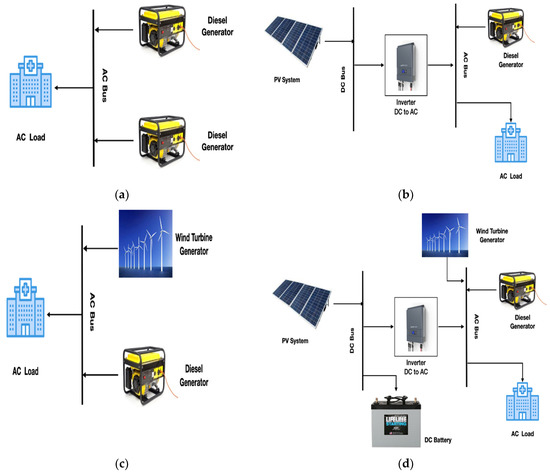
Figure 1.
Schematic diagram of the proposed hybrid energy system for different configurations. (a) Case 1: Diesel generators only. (b) Case 2: Diesel generator with wind turbine. (c) Case 3: DG with PV system. (d) Case 4: DG, PV, wind turbine and battery.
2.1. Wind Power
The electricity production from wind turbines can be achieve by converting the energy of the wind into electrical energy. The turbine consists of two or more rotating blades that are mechanically joined to a generator, and the turbine converts the kinetic energy in a rotor to electrical energy in the generator [26]. The height of the wind turbine has a great influence on the quantity of energy delivered, therefore, the wind energy conversion system can be computed as follows:
where A represents the swept surface area of the turbine in m3, stands for the air density in kg/m3, V denotes the wind speed in m/s and represents the power coefficient of the wind generator.
2.2. Solar PV
Electricity is generated from solar PV by utilizing PV panels and this can be employed to meet essential electrical loads such as residential loads, commercial loads and for healthcare facility loads. The performance of a solar PV system such as the power output and efficiency are determined by solar irradiation, temperature weather conditions and physical features of the study location. The configuration of a PV system can be based on parallel and series connections to meet the required electrical load demand at any time [27]. Therefore, the hourly power output for one solar PV panel can be estimated as [28]:
The total power produced by the solar PV system can be expressed as:
where , and are the area, solar irradiation and efficiency of the solar PV module, and is the number of solar PV modules.
2.3. Diesel Generator
The diesel generator is characterized by fossil fuel used to produce power for consumer usage. The diesel generator is a component of the hybrid energy system that is always considered as a standby in a power system with renewable energy sources. Renewable energy sources are characterized by an intermittent power supply thereby affecting power generation. The fuel consumption of the diesel generator, which depends largely on the fuel consumption rate can be modelled as [28]:
a, b and c are the diesel generator cost coefficient and PDG represents the power capacity of the diesel generators.
2.4. Battery Storage System
In this study, a battery is considered as an energy storage system to serve as a backup for the hybrid energy system. A lithium-ion battery is employed for storing the energy from solar PV modules. The efficiency of the battery depends on the previous state of charge of the battery, energy demand from the load point and the energy accessible from the PV. The state of charge of the battery can be expressed as:
where and are the power capacity for charging and discharging of the battery at time t, and and represent the charging and discharging efficiency of the battery, respectively.
The battery capacity must operate within the standard limits and this is a function of the rate of charging and discharging of the battery, the depth of discharge (dod) and the energy accessible from the PV.
where dod represents the depth of battery discharge.
3. Simulation Methodology
To obtain optimal system configuration based on the economic and emission impact, various hybrid systems are considered and an optimum scenario was determined by using an optimization software where each system configuration is represented as a mathematical model compelled by various constraints. This paper seeks to minimize the daily operation costs of producing electrical energy for healthcare facilities in remote areas as well as the emission emanating from fossil fuel generators. The hybrid systems are designed in such a way that they meet the peak load demand of the healthcare facility and supply its load based on the availability of PV and wind resources with a backup diesel generator. Therefore, the objective function and the model constraints can be mathematically expressed as follows:
Subject to the following constraints:
where and are the operation costs of diesel generators and emissions contribution from diesel generators, respectively;, and represent the optimal power produced by diesel generators DG, wind turbines and solar PV at time t, respectively; represents the charging and discharging capacity of the battery storage; represents the total power flowing in the PV and battery storage system at time t; is the hourly electrical load of the rural clinic; and are the minimum and maximum power rating of the diesel generators DG, respectively; and and represent the maximum power rating of wind turbines and the solar PV system, respectively.
The objective function in Equation (7) aimed at minimizing the costs of operation and emissions of the diesel generators. These are two incomparable objectives, hence, a weighting factor constraint such as in Equation (8) states that the sum of all weighting factors equals unity [29]. The power balance equation is given in Equation (9) and it indicates that the sum of the power produced from all the power sources must equal the energy demand by the load at any time t. Constraint (10) states that the total forecasted power by solar PV must be equal or greater than the total power obtainable from the charging and discharging of the battery storage system and the load power. Equations (11)–(13) are the boundary limits for the diesel generators, wind turbines and the solar PV system. Equation (14) is the state of charge constraint and it limits the available capacity of the battery.
3.1. Description of Case Study
In this study, the rural healthcare clinic considered for the assessment is a specialist hospital located in Ilumoba-Ekiti village in Ekiti State, in the southern part of Nigeria. This rural clinic is a government owned hospital that also provides healthcare delivery services to six neighboring communities that share a boundary with the host community. The study aimed at analysing the electrical appliances associated with laboratory equipment, vaccinations, maternity, medical consultations and lighting. The hospital is mostly run on a diesel generator during an emergency or when highly needed due to limited access to electricity in the community and its surroundings. Despite the significance of electricity for medical facilities, staff in this hospital do not have access to sufficient energy to perform their daily functions. This can lead to the poor storage of vaccines and the death of patients when attending unelectrified rural clinics. A hybrid energy system may be proposed for the rural healthcare facilities to improve energy supply to provide adequate service delivery in the rural clinic. The hybrid energy system comprises a wind turbine, solar PV, diesel generators and a battery storage system, which will provide energy for the proper operation of medical equipment. In order to properly design the hybrid energy for the system, an estimation of energy-consuming medical equipment is computed and the load profile for the rural healthcare clinic is presented in Table 2. Table 3 and Figure 2 present the solar parameters and wind speed of the selected site location. In this study, we considered four different configurations of hybrid energy systems for providing a stable power supply for rural clinics and these configurations are as follows:

Table 2.
Load profile of rural healthcare facilities.

Table 3.
Solar parameters of the site location.
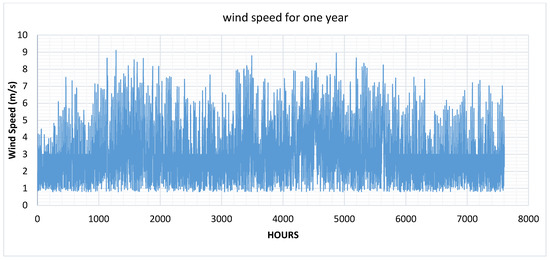
Figure 2.
Wind speed of the site location.
- Case 1: Diesel generators only;
- Case 2: Diesel generator with wind turbine;
- Case 3: Diesel generator with PV system;
- Case 4: Diesel generator, PV, wind turbine and battery.
3.2. Modelling and Optimization
In this study, the Advanced Interactive Multidimensional Modelling System (AIMMS) was used for modelling, simulating and optimally sizing the proposed hybrid energy system for different configurations. AIMMS is an optimization software that provides a setup for mathematical modelling and that aids in the solution of large-scale optimization problems in power systems. The solver employed in AIMMS is a CPLEX 12.6 solver.
4. Results and Discussion
This section evaluates the results obtained after the optimization of different hybrid configurations in an attempt to determine the most optimal in terms of minimized cost and emission. It assesses the outcomes to ascertain the impact of renewable energy resources on healthcare facilities in remote areas/off-grid locations and the results from the four case studies are discussed based on economic and environmental impacts.
Case 1: In this case study, the healthcare facility loads are supplied through the diesel generators with a peak capacity of 10 kW per generator, because it is designed such that no other source is available. The behavior of the three generators based on their power output is presented in Table 4. It is observed that the first generator operates at its peak capacity daily, while the second generator only reach its peak capacity when the hospital load is at its peak demand between 09:00 to 16:00 h each day. The third generator serves as a power reserve to support the power generation when both generators cannot meet the peak load demanded by the healthcare facilities at the peak period of the day as shown in Figure 1.

Table 4.
Optimal power output for Case 1.
Figure 3 presents the optimal power produced from diesel generators and Figure 4 presents the performance evaluation of the economic and emission parameters of this configuration. Since there is no other alternative source to supplement the diesel generators during operation, a large cost is incurred from the continuous operation of multiple diesel generators. Therefore, the minimized cost of running the three diesel generators is NGN 10,769/kWh. The environmental implication of running the three generators shows that this configuration produces an emission of 2536 lb/h. The high emission value obtained illustrates the environmental impacts the diesel generators have on the rural community.
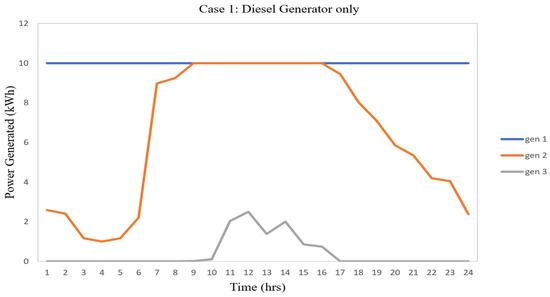
Figure 3.
Case 1: power output variation from diesel generators.
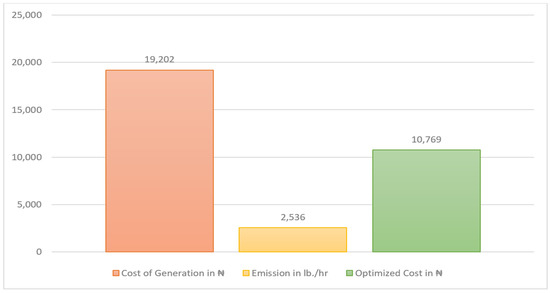
Figure 4.
Case 1: Performance evaluation of economics and emissions.
Case 2: This configuration uses diesel generators and wind turbines to meet the healthcare facility load. Table 5 presents the daily behavioral pattern of the diesel generators and the wind turbine generator. It can be observed that the integration of a wind turbine generator reduced the number of diesel generators in operation as shown in Figure 5. This in turn will reduce the level of degradation of the diesel generators as less stress in their operation reduces wear and tear. The economic and emission performance of the system can be seen in Figure 6. It shows that the operating conditions of the system considerably improved when compared to a system with only diesel generators in operation. The operational cost of running the system drastically reduced to NGN 9994/kWh and the emission sequentially reduced to 2385 lb/h because less generators are utilized and wind turbine generation produces no air pollution.

Table 5.
Optimal power output for Case 2.
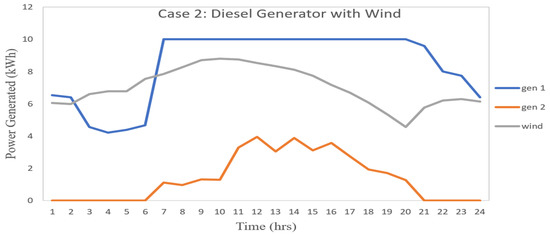
Figure 5.
Case 2: Power output variation from diesel and wind turbine generators.
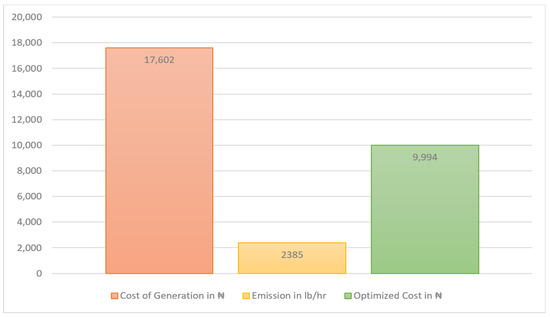
Figure 6.
Case 2: Performance evaluation of economics and emissions.
Case 3: In this case study, a solar PV system is added to the diesel generators to meet the required load demand of the rural clinic. Table 6 presents the power generated by the diesel generators and PV system. The results obtained in Figure 7 show that the power produced by the diesel generators significantly reduced owing to the presence of the PV system. However, there were inconsistencies in the availability of the PV system, which poses a setback to the configuration. The power produced from PV is only available between 08:00–18:00 h daily due to the intermittent nature of solar irradiance. In this case study, two diesel generators operated at minimal capacity. The cost of operation of this configuration is NGN 10,250/kWh and it is slightly lower when compared to a system mainly run by diesel generators. The environmental assessment shows a further reduction in emission production at 2387 lb/h as shown in Figure 8.

Table 6.
Optimal power output for Case 3.
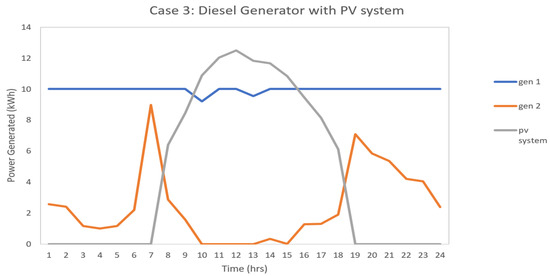
Figure 7.
Case 3: power output variation from diesel generators and PV generator.
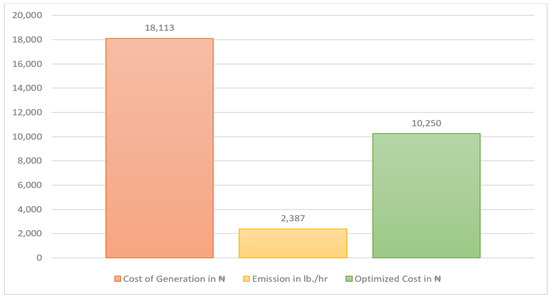
Figure 8.
Case 3: Performance evaluation of economics and emissions.
Case 4: The configuration of this case study utilized a diesel generator, wind turbine, solar PV and a battery storage system to meet the load demand of the clinic and the power produced by these generating units can be seen in Table 7. There is an indication that the power generated by the diesel generator drastically reduced when compared to other case studies as shown in Figure 9. It is further observed that the integration of the renewable energy sources with a battery storage system into the system enhance the performance of the hybrid energy system in meeting the load demand. This configuration shows an improvement in the economic and emission performance as presented in Figure 10. The result provides the lowest optimized cost of NGN 9312/kWh and emission performance at 2349 lb/h. This is an indication that the diesel generator is only operating at the least possible working capacity.

Table 7.
Optimal power output for Case 4.

Figure 9.
Case 4: Power output variation from diesel, PV and wind turbine generators.
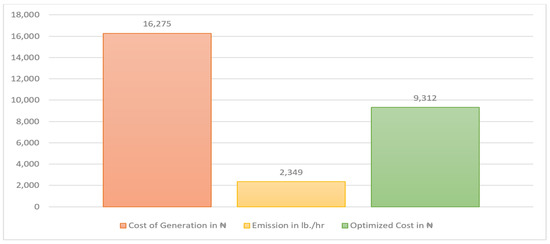
Figure 10.
Case 4: Performance evaluation of economics and emissions.
5. Conclusions
The main aim of this paper was to evaluate the impacts of a hybrid energy system that includes diesel generators, solar PV, wind turbines and a battery storage system utilizing different system configuration to meet the required load demand of rural healthcare facilities. The objective was to minimize the operational cost and emission from the diesel generators. The multi-objective optimization model developed was solved using Algebraic Modeling Language. Four different configurations were used to assess the economic and environmental performance of the proposed model. This research is proposed to assist decision makers in planning a cost-effective sustainable energy system for the proper operation of a healthcare center in a rural community in Nigeria. The results obtained from this paper indicate the impact of the incorporation of renewable energy sources on the optimality of the cost of generation and emission production. The most preferrable system with the optimal amount of power produced was found to be the system with the combination of a diesel generator, wind turbine, solar PV and a battery storage system. However, the other two configurations are preferred to powering the hospital load using only diesel generators. In conclusion, it can be established that healthcare facilities can be effectively put into operation with minimal operation costs by utilizing renewable energy sources.
Author Contributions
Conceptualization, S.L.G.; methodology, S.L.G.; software, S.L.G.; validation, S.L.G. and N.I.N.; formal analysis, S.L.G.; investigation, S.L.G.; resources, S.L.G.; data curation, S.L.G.; writing—original draft preparation, S.L.G.; writing—review and editing, S.L.G. and N.I.N.; visualization, S.L.G.; supervision, S.L.G. and N.I.N.; project administration, N.I.N. All authors have read and agreed to the published version of the manuscript.
Funding
This research received no external funding.
Institutional Review Board Statement
Not applicable.
Informed Consent Statement
Not applicable.
Conflicts of Interest
The authors declare no conflict of interest.
References
- Franco, A.; Shaker, M.; Kalubi, D.; Hostettler, S. A review of sustainable energy access and technologies for healthcare facilities in the Global South. Sustain. Energy Technol. Assess. 2017, 22, 92–105. [Google Scholar] [CrossRef]
- Olatomiwa, L.; Blanchard, R.; Mekhilef, S.; Akinyele, D. Hybrid renewable energy supply for rural healthcare facilities: An approach to quality healthcare delivery. Sustain. Energy Technol. Assess. 2018, 30, 121–138. [Google Scholar] [CrossRef] [Green Version]
- Ayodele, T.R.; Mosetlhe, T.C.; Yusuff, A.A.; Ogunjuyigbe, A.S.O. Off-grid hybrid renewable energy system with hydrogen storage for South African rural community health clinic. Int. J. Hydrogen Energy 2021, 46, 19871–19885. [Google Scholar] [CrossRef]
- Gbadamosi, S.L.; Nwulu, N.I. A comparative analysis of generation and transmission expansion planning models for power loss minimization. Sustain. Energy Grids Netw. 2021, 26, 100456. [Google Scholar] [CrossRef]
- Gbadamosi, S.L.; Nwulu, N.I. Optimal Power Dispatch and Reliability Analysis of Hybrid CHP-PV-Wind Systems in Farming Applications. Sustainability 2020, 12, 8199. [Google Scholar] [CrossRef]
- Ali, F.; Ahmar, M.; Jiang, Y.; Alahmad, M. A techno-economic assessment of hybrid energy systems in rural Pakistan. Energy 2021, 215, 119103. [Google Scholar] [CrossRef]
- Ayodele, T.R.; Samson, A.; Ogunjuyigbe, O. Evaluation of solar powered water pumping system: The case study of three selected Abattoirs in Ibadan, Nigeria. Int. J. Sustain. Eng. 2019, 12, 58–69. [Google Scholar] [CrossRef]
- Ayodele, E.; Misra, S.; Damasevicius, R.; Maskeliunas, R. Hybrid microgrid for micro finance institutions in rural areas—A field demonstration in West Africa. Sustain. Energy Technol. Assess. 2019, 35, 89–97. [Google Scholar]
- Sánchez, A.S.; Torres, E.A.; Kalid, R.A. Renewable energy generation for the rural electrification of isolated communities in the Amazon Region. Renew. Sustain. Energy Rev. 2015, 49, 278–290. [Google Scholar] [CrossRef]
- Bagheri, M.; Shirzadi, N.; Bazdar, E.; Kennedy, C.A. Optimal planning of hybrid renewable energy infrastructure for urban sustainability: Green Vancouver. Renew. Sustain. Energy Rev. 2018, 95, 254–264. [Google Scholar] [CrossRef]
- Das, M.; Anil, M.; Singh, K.; Biswas, A. Techno-economic optimization of an off-grid hybrid renewable energy system using metaheuristic optimization approaches—Case of a radio transmitter station in India. Energy Convers. Manag. 2019, 185, 339–352. [Google Scholar] [CrossRef]
- Oladigbolu, J.O.; Al-turki, Y.A.; Olatomiwa, L. Comparative study and sensitivity analysis of a standalone hybrid energy system for electrification of rural healthcare facility in Nigeria. Alex. Eng. J. 2021, 60, 5547–5565. [Google Scholar] [CrossRef]
- Jahangir, M.H.; Eslamnezhad, S.; Mousavi, S.A.; Askari, M. Multi-year sensitivity evaluation to supply prime and deferrable loads for hospital application using hybrid renewable energy systems. J. Build. Eng. 2021, 40, 102733. [Google Scholar] [CrossRef]
- Raghuwanshi, S.S.; Arya, R. Reliability evaluation of stand-alone hybrid photovoltaic energy system for rural healthcare centre. Sustain. Energy Technol. Assess. 2020, 37, 100624. [Google Scholar] [CrossRef]
- Lemuel, A.; Lemence, G.; Tamayao, M.M. Energy consumption profile estimation and benefits of hybrid solar energy system adoption for rural health units in the Philippines. Renew. Energy 2021, 178, 651–668. [Google Scholar]
- Ayodele, T.R.; Ogunjuyigbe, A.S.O.; Babatunde, J.B. Sustainable electricity generation in rural communities using hybrid energy system: The case study of Ojataye Village. Int. J. Renew. Energy 2016, 11, 43–56. [Google Scholar]
- Adaramola, M.S.; Oyewola, O.M.; Paul, S.S. Technical and economic assessment of hybrid energy systems in South-West Nigeria. Energy Explor. Exploit. 2012, 30, 533–551. [Google Scholar] [CrossRef] [Green Version]
- Akram, F.; Asghar, F.; Asghar, M.; Amjad, W.; Manzoor, M.O.; Munir, A. Techno-economic optimization analysis of stand-alone renewable energy system for remote areas. Sustain. Energy Technol. Assess. 2020, 38, 100673. [Google Scholar] [CrossRef]
- Li, C.; Zhou, D.; Zheng, Y. Techno-economic comparative study of grid-connected PV power systems in five climate zones, China. Energy 2018, 165, 1352–1369. [Google Scholar] [CrossRef]
- Islam, S. A techno-economic feasibility analysis of hybrid renewable energy supply options for a grid-connected large office building in southeastern part of France. Sustain. Cities Soc. 2018, 38, 492–508. [Google Scholar] [CrossRef]
- Potosi, S.L.; Peña-Gallardo, R.; Hernández-Rodriguez, A.; Segundo-Ramírez, J. Techno-economic evaluation of a grid-connected hybrid PV-Wind power generation system in San Luis Potosi, Mexico. In Proceedings of the 2017 IEEE International Autumn Meeting on Power, Electronics and Computing, Ixtapa, Mexico, 8–10 November 2017; pp. 1–6. [Google Scholar]
- Al-shara, A.; Sahin, A.Z.; Ayar, T.; Yilbas, B.S. Techno-economic analysis and optimization of solar and wind energy systems for power generation and hydrogen production in Saudi Arabia. Renew. Sustain. Energy Rev. 2017, 69, 33–49. [Google Scholar] [CrossRef]
- Ma, W.; Xue, X.; Liu, G.; Zhou, R. Techno-economic evaluation of a community-based hybrid renewable energy system considering site-specific nature. Energy Convers. Manag. 2018, 171, 1737–1748. [Google Scholar] [CrossRef]
- Ahmad, J.; Imran, M.; Khalid, A.; Iqbal, W.; Ashraf, S.R.; Adnan, M.; Ali, S.F.; Khokhar, K.S. Techno economic analysis of a wind-photovoltaic-biomass hybrid renewable energy system for rural electrification: A case study of Kallar Kahar. Energy 2018, 148, 208–234. [Google Scholar] [CrossRef]
- Bartolucci, L.; Cordiner, S.; Mulone, V.; Rossi, J.L. Hybrid renewable energy systems for household ancillary services. Electr. Power Energy Syst. 2019, 107, 282–297. [Google Scholar] [CrossRef]
- Gbadamosi, S.L.; Nwulu, N.I. A multi-period composite generation and transmission expansion planning model incorporating renewable energy sources and demand response. Sustain. Energy Technol. Assess. 2020, 39, 100726. [Google Scholar] [CrossRef]
- Gbadamosi, S.L.; Nwulu, N.I.; Sun, Y. Multi-objective optimisation for composite generation and transmission expansion planning considering offshore wind power and feed-in tariffs. IET Renew. Power Gener. 2018, 12, 1687–1697. [Google Scholar] [CrossRef]
- Adefarati, T.; Bansal, R.C. Reliability, economic and environmental analysis of a microgrid system in the presence of renewable energy resources. Appl. Energy 2019, 236, 1089–1114. [Google Scholar] [CrossRef]
- Gbadamosi, S.L.; Nwulu, N.I.; Sun, Y. Harmonic and power loss minimization in power systems incorporating renewable energy sources and locational marginal pricing. J. Renew. Sustain. Energy 2018, 10, 055501. [Google Scholar] [CrossRef]
Publisher’s Note: MDPI stays neutral with regard to jurisdictional claims in published maps and institutional affiliations. |
© 2022 by the authors. Licensee MDPI, Basel, Switzerland. This article is an open access article distributed under the terms and conditions of the Creative Commons Attribution (CC BY) license (https://creativecommons.org/licenses/by/4.0/).